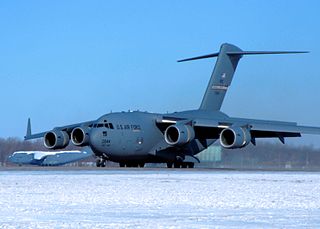
The 445th Airlift Wing is an Air Reserve Component of the United States Air Force. It is assigned to the Fourth Air Force, Air Force Reserve Command, stationed at Wright-Patterson Air Force Base, Ohio. If mobilized, the wing is gained by the Air Mobility Command.

The 89th Airlift Wing of the United States Air Force is based at Joint Base Andrews and has an operational force of over 1,000 personnel. The 89th provides global Special Air Mission (SAM) airlift, logistics, aerial transport and communications for the president, vice president, combatant commanders, senior leaders and the global mobility system as tasked by the White House, Chief of Staff of the Air Force, and Air Mobility Command.

The 442d Fighter Wing is an Air Reserve Component of the United States Air Force. It is assigned to Tenth Air Force, Air Force Reserve Command, stationed at Whiteman Air Force Base, Missouri.

The 700th Airlift Squadron is part of the 94th Airlift Wing at Dobbins Air Reserve Base, Georgia. It operates Lockheed C-130 Hercules aircraft providing global airlift.

The 701st Airlift Squadron is part of the 315th Airlift Wing at Charleston Air Force Base, South Carolina. It operates Boeing C-17 Globemaster III aircraft providing global airlift.
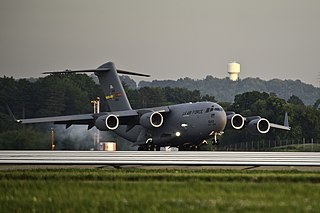
The 729th Airlift Squadron is a United States Air Force Reserve squadron, assigned to the 452d Operations Group, stationed at March Air Reserve Base, California. It operates Boeing C-17 Globemaster III aircraft providing global airlift any time, any place.

The 730th Air Mobility Training Squadron is an Air Force reserve unit stationed at Altus Air Force Base, Oklahoma, where it trains airmen on Boeing C-17 Globemaster III, Boeing KC-135 Stratotanker and Boeing KC-46 Pegasus aircraft systems. It is assigned to the 507th Operations Group at Tinker Air Force Base, Oklahoma, but performs its training mission under the direction of the 97th Air Mobility Wing of Air Education and Training Command.

The 482d Operations Group is a United States Air Force Reserve unit assigned to the 482d Fighter Wing. It is stationed at Homestead Air Reserve Base, Florida.

The 445th Operations Group is the flying component of the 445th Airlift Wing, assigned to Fourth Air Force of the United States Air Force Reserve. The group is stationed at Wright-Patterson Air Force Base, Ohio.

The 319th Operations Group is a United States Air Force unit assigned to 319th Reconnaissance Wing, Air Combat Command. It is stationed at Grand Forks Air Force Base, North Dakota operating RQ-4 Global Hawk remotely piloted aircraft (RPA) in the intelligence, surveillance and reconnaissance (ISR) role.

The 438th Air Expeditionary Wing was a United States Air Force unit operating in Afghanistan and assigned to United States Air Forces Central. The wing trained Afghan Air Force members, including pilots.

The 89th Operations Group is the operational flying component of the United States Air Force 89th Airlift Wing. It is stationed at Andrews Air Force Base, Maryland.
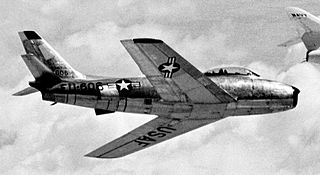
The 813th Fighter-Bomber Squadron is an inactive United States Air Force unit. Its last assignment was with 482d Fighter-Bomber Group at Dobbins Air Force Base, Georgia.

The 702d Expeditionary Airlift Squadron is a provisional United States Air Force unit. It is assigned to Air Combat Command to activate or inactivate as needed. It was active at Kandahar Airfield from 2011 to 2012.

The 87th Fighter-Bomber Squadron is an inactive United States Air Force unit. Its last assignment was with the 438th Fighter-Bomber Group, based at General Mitchell Field, Milwaukee, Wisconsin, where it was inactivated on 16 November 1957.
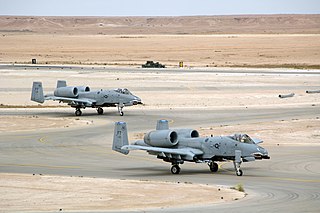
The United States Air Force's 438th Air Expeditionary Advisory Group is a provisional unit assigned to United States Air Forces Central to activate or inactivate as needed. It was last active in Al Anbar province, Iraq to provide close-air support to coalition forces in the region with Fairchild Republic A-10 Thunderbolt II aircraft. It was composed of deployed aircraft, equipment and personnel from Air Force units around the world.

The 88th Fighter-Bomber Squadron is an inactive United States Air Force unit. Its last assignment was with the 438th Fighter-Bomber Group, based at General Mitchell Field, Milwaukee, Wisconsin. It was inactivated on 16 November 1957.
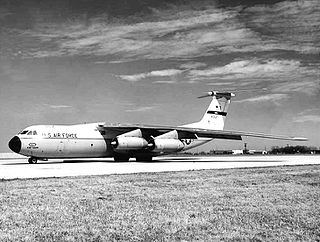
The 335th Airlift Squadron is an inactive United States Air Force Reserve unit. It was last active with the 514th Operations Group at McGuire Air Force Base, New Jersey, where it was inactivated on 30 September 1995

The 24th Fighter-Bomber Squadron is an inactive United States Air Force unit. It was organized in February 1942 as the 24th Transport Squadron and served as a training unit for I Troop Carrier Command until disbanding in a general reorganization of Army Air Forces training units in 1944. The squadron was reconstituted in the reserves in 1949 and served until May 1951, when it was called to active duty for the Korean War. It was then inactivated, and its personnel were assigned to other units. When the reserves reactivated their operational units in 1952, it was activated as the 24th Fighter-Bomber Squadron. When the reserve fighter mission was concentrated in the Air National Guard in 1957, the squadron was inactivated and its assets transferred to elements of the 94th Troop Carrier Wing

The 25th Fighter-Bomber Squadron is an inactive United States Air Force unit. It was organized in February 1942 as the 25th Transport Squadron and served as a training unit for I Troop Carrier Command until disbanding in a general reorganization of Army Air Forces training units in 1944. The squadron was reconstituted in the reserves in 1949 and served until May 1951, when it was called to active duty for the Korean War. It was then inactivated, and its personnel were assigned to other units. When the reserves reactivated their operational units in 1952, it was activated as the 25th Fighter-Bomber Squadron. When the reserve fighter mission was concentrated in the Air National Guard in 1957, the squadron was inactivated and its assets transferred to elements of the 94th Troop Carrier Wing


























